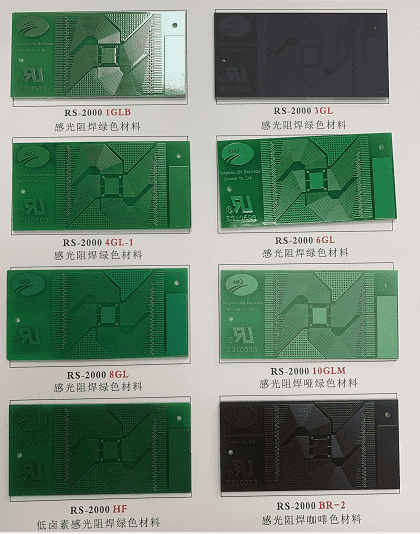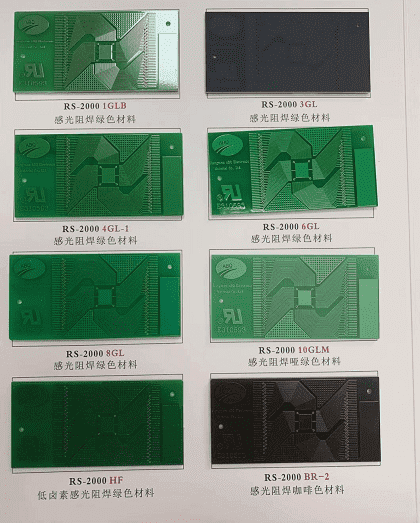PCB raw materials refer to the basic raw materials required for the manufacture of PCBs (circuit boards), which can also be called PCB substrate materials. From the beginning of the 20th century to the end of the 1940s, it was the embryonic stage of the development of the PCB substrate material industry. Its development characteristics are mainly manifested in: resins, reinforcing materials and insulating substrates for substrate materials emerged in large numbers during this period, and the technology was initially explored. These have created the necessary conditions for the advent and development of the most typical substrate material for printed circuit boards – copper clad laminates.
On the other hand, the PCB manufacturing technology, which mainly uses the metal foil etching method (subtractive method) to manufacture circuits, has been initially established and developed. It plays a decisive role in the determination of the structural composition and characteristic conditions of the copper clad laminate. The development of circuit board raw materials has gone through nearly 50 years. In addition, there are about 50 years of scientific experiments and explorations on the basic raw materials used in this industry – resin and reinforcing materials, and the PCB board substrate material industry has accumulated a history of nearly a hundred years. The development of each stage of the substrate material industry is driven by the innovation of electronic complete machine products, semiconductor manufacturing technology, electronic installation technology, and electronic circuit manufacturing technology. Introduction of common materials and parameters of circuit boards PCB board knowledge and standards.
At present, there are the following types of copper-clad boards that are widely used in my country : Classification of copper clad plates There are many ways to classify copper clad laminates. Generally, according to the different reinforcing materials of the board, it can be divided into five categories: paper base, glass fiber cloth base, composite base (CEM series), laminated multilayer board base and special material base (ceramic, metal core base, etc.). According to the different resin adhesives used in the board, the common paper-based CCI is classified. There are: phenolic resin (XPc, XxxPC, FR-1, FR-2, etc.), epoxy resin (FE-3), polyester resin and other types. The common glass fiber cloth base CCL has epoxy resin (FR-4, FR-5), which is the most widely used glass fiber cloth base type. In addition, there are other special resins (with glass fiber cloth, polyamide fiber, non-woven fabric, etc. as additional materials): bismaleimide modified triazine resin (BT), polyimide resin (PI) , Diphenylene ether resin (PPO), maleic anhydride imide – styrene resin (MS), polycyanate resin, polyolefin resin, etc. According to the classification of flame retardant properties of CCL, it can be divided into flame retardant (UL94-VO, UL94-V1 grade) and non-flame retardant (UL94-HB grade) two types of boards. Knowledge of copper cladding In recent years, a new type of CCL that does not contain bromines has emerged with the emphasis on environmental protection issues, which is called green flame retardant CCL. With the rapid development of electronic product technology, there are higher performance requirements for CCL. Therefore, from the performance classification of CCL, it is divided into general performance CCL, low dielectric constant CCL, high resistance-5), which is currently the most widely used type of glass fiber cloth base. In addition, there are other special resins (with glass fiber cloth, polyamide fiber, non-woven fabric, etc. as additional materials): bismaleimide modified triazine resin (BT), polyimide resin (PI) , Diphenylene ether resin (PPO), maleic anhydride imide – styrene resin (MS), polycyanate resin, polyolefin resin, etc. According to the classification of flame retardant properties of CCL, it can be divided into flame retardant (UL94-VO, UL94-V1 grade) and non-flame retardant (UL94-HB grade) two types of boards. In the past year or two, as more attention is paid to environmental protection issues, a new type of CCL without bromine has been identified in the flame-retardant CCL, which can be called “green flame-retardant cCL”. With the rapid development of electronic product technology, there are higher performance requirements for cCL.
Therefore, from the performance classification of CCL, it is divided into general performance CCL, low dielectric constant CCL, high heat resistance CCL (the L of the general board is above 150 ℃), and low thermal expansion coefficient CCL (generally used on packaging substrates). ) and other types. With the development and continuous progress of electronic technology, new requirements are constantly put forward for printed board substrate materials, thereby promoting the continuous development of copper clad laminate standards. Main criteria for substrate materials National standards: my country’s national standards for substrate materials include GB/T4721-47221992 and GB4723-4725-1992. The copper clad laminate standard in Taiwan is the CNS standard, which is based on the Japanese JIs standard and was released in 1983.
International standards: Japanese JIS standard, American ASTM, NEMA, MIL, IPc, ANSI, UL standard, British Bs standard, German DIN, VDE standard, French NFC, UTE standard, Canadian CSA standard, Australia AS Standard, the FOCT standard of the former Soviet Union, the international IEC standard, etc.; the suppliers of PCB design materials, the common and commonly used ones are: Shengyi\Jiantao\International, etc. parameter Accepted documents: protel autocad powerpcb orcad gerber or solid board copy board, etc.
Type of sheet: CEM-1, CEM-3 FR4, high TG material; Maximum board size: 600mm700mm(24000mil27500mil) Processing board thickness: 0.4mm-4.0mm (15.75mil-157.5mil) The highest number of processing layers: 16Layers Copper foil layer thickness: 0.5-4.0(oz) Finished plate thickness tolerance: +/-0.1mm(4mil) Forming size tolerance: Computer milling: 0.15mm (6mil) Die punching plate: 0.10mm (4mil) Minimum line width/spacing: 0.1mm(4mil) Line width control ability: <+-20% Finished minimum drilling hole diameter: 0.25mm (10mil) Finished minimum punching hole diameter: 0.9mm (35mil) Finished Aperture Tolerance: PTH: +-0.075mm (3mil) NPTH: +-0.05mm(2mil) Finished hole wall copper thickness: 18-25um (0.71-0.99mil) Minimum SMT chip pitch: 0.15mm (6mil) Surface coating: chemical immersion gold, tin spraying, nickel gold plating (water/soft gold), silk screen blue glue, etc. Solder mask thickness on board: 10-30μm (0.4-1.2mil) Peel Strength: 1.5N/mm (59N/mil) Solder mask hardness: >5H Solder Mask Capability: 0.3-0.8mm(12mil-30mil) Dielectric constant: ε= 2.1-10.0 Insulation resistance: 10KΩ-20MΩ Characteristic impedance: 60 ohm±10% Thermal shock: 288℃, 10 sec Finished board warpage: < 0.7% Product application: communication equipment, automotive electronics, instrumentation, global positioning system, computer, MP4, power supply, home appliances, etc.
PCB Substrate Material Classification PCB substrate materials can be basically divided into paper-based printed boards, epoxy glass fiber cloth printed boards, composite substrate printed boards, special substrate printed boards and other substrate materials according to the properties of the materials. paper-based printed board This type of printed board is made of fiber paper as a reinforcing material, dipped in a resin solution (phenolic resin, epoxy resin, etc.), dried and processed, covered with glued electrolytic copper foil, and pressed by high temperature and high pressure. According to the models specified by the American ASTM/NEMA standard, the main varieties are FR-1, FR-2, FR-3 (the above are flame retardant XPC, XXXPC (the above are non-flame retardant). 85% of global paper-based printed boards The above markets are in Asia.
The most commonly used and mass-produced are FR-1 and XPC printed boards. Epoxy glass fiber cloth printed board This type of printed board is a substrate using epoxy or modified epoxy resin as an adhesive, and glass fiber cloth as a reinforcing material. It is the printed board with the largest output in the world and the most used type of printed board. In the ASTM/NEMA standard, there are four types of epoxy fiberglass cloth board: G10 (not flame retardant), FR-4 (flame retardant); G11 (retain thermal strength, not flame retardant), FR-5 (retain heat strength, flame retardant). In fact, non-flame retardant products are decreasing year by year, and FR-4 accounts for the vast majority. Composite substrate printed board This type of printed board is a substrate that uses different reinforcing materials to form the face and core material. The CCL substrates used are mainly CEM series, of which CEM-1 and CEM-3 are the most representative. CEM-1 base material is glass fiber cloth, core material is paper, resin is epoxy, flame retardant; CEM-3 base material is glass fiber cloth, core material is glass fiber paper, resin is epoxy, flame retardant. The basic characteristics of composite-based printed boards are comparable to FR-4, while the cost is lower, and the machining performance is better than FR-4. Special substrate printed board Metal substrates (aluminum-based, copper-based, iron-based or Invar steel), ceramic substrates, can be made into metal (ceramic)-based single, double, multi-layer printed boards or metal core printed boards according to their characteristics and uses.

